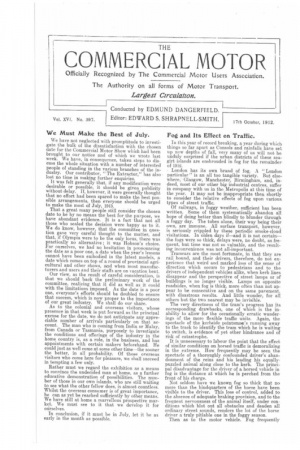Fog and Its Effect on Traffic.
Page 1

Page 2

If you've noticed an error in this article please click here to report it so we can fix it.
In this year of record breaking, a year during which things so far apart as Consols and rainfalls have set up new depths of fall, very many of us will not be unduly surprised if the urban districts of these seagirt islands are enshrouded in fog for the remainder of 1912.
London has its own brand of fog. A "London particular" is an all too tangible variety. But elsewhere, Glasgow, Manchester, Birmingham, and, indeed, most of our other big industrial centres, suffer in company with us in the Metropolis at this time of the year. It may not be inappropriate then shortly to consider the relative effects of fog upon various types of street traffic. Of railways, in foggy weather, sufficient has been written. Some of them systematically abandon all hope of doing better than blindly to blunder through a foggy day. The tubes alone, their way being their own, are immune. All surface transport, however, is seriously crippled by these periodic smoke-cloud visitations. In olden days if—and it is not certain— the fogs were so thick, delays were, no doubt, as frequent, but time was not so valuable, and the resulting inconvenience was not all-important.. Tramcars are the most fortunate, in that they are rail bound, and their drivers, therefore, do not experience that weird and marked loss of the sense of direction which occurs to pedestrians and to the drivers of independent vehicles alike, when kerb lines disappear and the perspective of street lamps or of' buildings is no longer visible. Lamps on opposite roadsides, when fog is thick, more often than not appear to be consecutive and on the same pavement, with disastrous results. And little wonder, for all others but the two nearest may be invisible. The very directness of the tram's progress has its corresponding drawbacks, one of which is the inability to allow for the occasionally erratic wander. ings of the more flexible traffic units. Again, the spectacle of the kerbside pointsman's running away to the track to identify the tram which he is waiting to switch, is evidence of yet other hindrance and of risk of catastrophe.
It is unnecessary to labour the point that the effect of similar conditions on horsed traffic is demoralizing in the extreme. How frequently may be seen the spectacle of a thoroughly confounded driver's abandonment of the reins and his leading his equallypuzzled animal along close to the kerb. The principal disadvantage for the driver of a horsed vehicle in fog is the distance at which he is perched from the front of his charge.
Not seldom have we known fog so thick that no more than the hindquarters of the horse have been visible to the driver. This loss of control, added to the absence of adequate braking provision, and to the frequent nervousness of the animal itself, under conditions which blot out all obstacles and deaden all ordinary street sounds, renders the lot of the horse driver a truly pitiable one in the foggy season. Then as to the motor vehicle. Fog frequently
brings with it treacherous and greasy road surfaces, and these any careful driver dreads. Otherwise the man at the wheel has a better chance in such conditions than have his fellow-users of the highway. He is well placed for observation ahead. His vehicle can be more readily controlled. Its brakes are or should be rapid and effective, and there is nothing under the bonnet to get disturbed at the unusual and eerie conditions.
No driver likes fog, but if he be given a choice of tram, horse or motor, he would most certainly choose one of the mechanically-propelled methods. If the foot passenger be asked which he prefers under such conditions, his trenchant remarks will, we hope, be lost in the murky atmosphere, as he dives for the nearest tube hole, thankful that there is one method of getting about which is unaffected by the fog.




























